#lcrd
Explore tagged Tumblr posts
Link
Welcome, stargazers, to another enlightening episode of Astronomy Daily! Your host, Tim Gibbs, and his AI co-host, Hallie, are here to navigate the cosmic news. **Quick Announcements:**- Catch all episodes, past, present, and future, on [spacenuts.io](http://spacenuts.io) and [bytes.com](http://bytes.com).- Don't miss "Space Nuts" with Professor Fred Watson and Andrew Dunkley.- Subscribe to our daily newsletter for hand-picked stories.- Join our Facebook group, "Space Nuts podcast group," to discuss all things space. **This Week’s Cosmic Highlights:** 1. **NASA's Illumity Payload Heads to ISS:** - A groundbreaking venture to enhance space-to-Earth communications. - Laser technology promises faster data transmission, revolutionizing space communication. - The mission showcases the potential of infrared light in transmitting crucial scientific data. 2. **Mysteries Unraveled with the James Webb Space Telescope:** - Recent study reveals the presence of rare elements in a Gamma Ray Burst (GRB 230307A). - The discovery, highlighting elements like allureum and possibly iodine, marks a significant step in understanding cosmic phenomena. - The event, one of the brightest ever recorded, provides insights into the creation of elements in the universe. 3. **ESA and JAXA's EarthCare Mission:** - A forthcoming launch set to deepen our understanding of Earth’s climate system. - The mission focuses on the critical role of clouds and aerosols in climate change. - EarthCare aims to enhance climate models and predictions through advanced technology. **Special Mention:**- "Deep Sky," a must-watch iMax movie by Nathaniel Khan, brings the marvels of the James Webb Space Telescope to the big screen. **Hallie’s Fun Segment:**- Ending with a spark of humor, Hallie shares some quirky science jokes to lighten the mood. Thank you for joining us in exploring the universe’s wonders. Tune in next week for more cosmic insights. Until then, keep looking up!
#communications#data#demonstration#exploration#illumity#infrared#international#iss#laser#lcrd#light#missions#nasa#payload#scan#science#space#station#technology#transmission
0 notes
Text
All-Star Moments in Space Communications and Navigation
How do we get information from missions exploring the cosmos back to humans on Earth? Our space communications and navigation networks – the Near Space Network and the Deep Space Network – bring back science and exploration data daily.
Here are a few of our favorite moments from 2024.

1. Hip-Hop to Deep Space
The stars above and on Earth aligned as lyrics from the song “The Rain (Supa Dupa Fly)” by hip-hop artist Missy Elliott were beamed to Venus via NASA’s Deep Space Network. Using a 34-meter (112-foot) wide Deep Space Station 13 (DSS-13) radio dish antenna, located at the network’s Goldstone Deep Space Communications Complex in California, the song was sent at 10:05 a.m. PDT on Friday, July 12 and traveled about 158 million miles from Earth to Venus — the artist’s favorite planet. Coincidentally, the DSS-13 that sent the transmission is also nicknamed Venus!

NASA's PACE mission transmitting data to Earth through NASA's Near Space Network.
2. Lemme Upgrade You
Our Near Space Network, which supports communications for space-based missions within 1.2 million miles of Earth, is constantly enhancing its capabilities to support science and exploration missions. Last year, the network implemented DTN (Delay/Disruption Tolerant Networking), which provides robust protection of data traveling from extreme distances. NASA’s PACE (Plankton, Aerosol, Cloud, ocean Ecosystem) mission is the first operational science mission to leverage the network’s DTN capabilities. Since PACE’s launch, over 17 million bundles of data have been transmitted by the satellite and received by the network’s ground station.
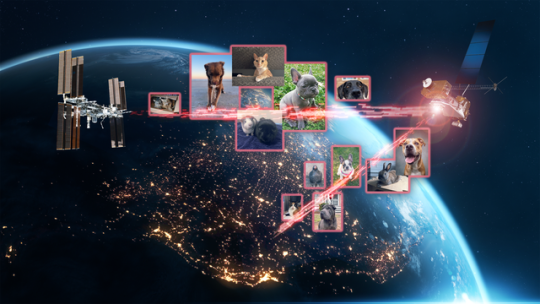
A collage of the pet photos sent over laser links from Earth to LCRD and finally to ILLUMA-T (Integrated LCRD Low Earth Orbit User Modem and Amplifier Terminal) on the International Space Station. Animals submitted include cats, dogs, birds, chickens, cows, snakes, and pigs.
3. Who Doesn’t Love Pets?
Last year, we transmitted hundreds of pet photos and videos to the International Space Station, showcasing how laser communications can send more data at once than traditional methods. Imagery of cherished pets gathered from NASA astronauts and agency employees flowed from the mission ops center to the optical ground stations and then to the in-space Laser Communications Relay Demonstration (LCRD), which relayed the signal to a payload on the space station. This activity demonstrated how laser communications and high-rate DTN can benefit human spaceflight missions.

4K video footage was routed from the PC-12 aircraft to an optical ground station in Cleveland. From there, it was sent over an Earth-based network to NASA’s White Sands Test Facility in Las Cruces, New Mexico. The signals were then sent to NASA’s Laser Communications Relay Demonstration spacecraft and relayed to the ILLUMA-T payload on the International Space Station.
4. Now Streaming
A team of engineers transmitted 4K video footage from an aircraft to the International Space Station and back using laser communication signals. Historically, we have relied on radio waves to send information to and from space. Laser communications use infrared light to transmit 10 to 100 times more data than radio frequency systems. The flight tests were part of an agency initiative to stream high-bandwidth video and other data from deep space, enabling future human missions beyond low-Earth orbit.

The Near Space Network provides missions within 1.2 million miles of Earth with communications and navigation services.
5. New Year, New Relationships
At the very end of 2024, the Near Space Network announced multiple contract awards to enhance the network’s services portfolio. The network, which uses a blend of government and commercial assets to get data to and from spacecraft, will be able to support more missions observing our Earth and exploring the cosmos. These commercial assets, alongside the existing network, will also play a critical role in our Artemis campaign, which calls for long-term exploration of the Moon.

On Monday, Oct. 14, 2024, at 12:06 p.m. EDT, a SpaceX Falcon Heavy rocket carrying NASA’s Europa Clipper spacecraft lifts off from Launch Complex 39A at NASA’s Kennedy Space Center in Florida.
6. 3, 2, 1, Blast Off!
Together, the Near Space Network and the Deep Space Network supported the launch of Europa Clipper. The Near Space Network provided communications and navigation services to SpaceX’s Falcon Heavy rocket, which launched this Jupiter-bound mission into space! After vehicle separation, the Deep Space Network acquired Europa Clipper’s signal and began full mission support. This is another example of how these networks work together seamlessly to ensure critical mission success.

Engineer Adam Gannon works on the development of Cognitive Engine-1 in the Cognitive Communications Lab at NASA’s Glenn Research Center.
7. Make Way for Next-Gen Tech
Our Technology Education Satellite program organizes collaborative missions that pair university students with researchers to evaluate how new technologies work on small satellites, also known as CubeSats. In 2024, cognitive communications technology, designed to enable autonomous space communications systems, was successfully tested in space on the Technology Educational Satellite 11 mission. Autonomous systems use technology reactive to their environment to implement updates during a spaceflight mission without needing human interaction post-launch.

A first: All six radio frequency antennas at the Madrid Deep Space Communication Complex, part of NASA’s Deep Space Network (DSN), carried out a test to receive data from the agency’s Voyager 1 spacecraft at the same time.
8. Six Are Better Than One
On April 20, 2024, all six radio frequency antennas at the Madrid Deep Space Communication Complex, part of our Deep Space Network, carried out a test to receive data from the agency’s Voyager 1 spacecraft at the same time. Combining the antennas’ receiving power, or arraying, lets the network collect the very faint signals from faraway spacecraft.
Here’s to another year connecting Earth and space.
Make sure to follow us on Tumblr for your regular dose of space!
1K notes
·
View notes
Text
NASA is demonstrating laser communications on multiple missions—showcasing the benefits infrared light can have for science and exploration missions transmitting terabytes of important data. The International Space Station is getting a "flashy" technology demonstration this November. The ILLUMA-T (Integrated Laser Communications Relay Demonstration Low Earth Orbit User Modem and Amplifier Terminal) payload is launching to the International Space Station to demonstrate how missions in low Earth orbit can benefit from laser communications. Laser communications uses invisible infrared light to send and receive information at higher data rates, providing spacecraft with the capability to send more data back to Earth in a single transmission and expediting discoveries for researchers. Managed by NASA's Space Communications and Navigation (SCaN) program, ILLUMA-T is completing NASA's first bi-directional, end-to-end laser communications relay by working with the agency's LCRD (Laser Communications Relay Demonstration). LCRD launched in December 2021 and is currently demonstrating the benefits of laser communications from geosynchronous orbit by transmitting data between two ground stations on Earth in a series of experiments.
Continue Reading
83 notes
·
View notes
Text


NASA terminal transmits first laser communications uplink to space
NASA's LCOT (Low-Cost Optical Terminal), a ground station made of modified commercial hardware, has transmitted its first laser communications uplink to the TBIRD (TeraByte Infrared Delivery), a tissue box-sized payload formerly in low Earth orbit.
During the first live sky test, NASA's LCOT produced enough uplink intensity for the TBIRD payload to identify the laser beacon, connect, and maintain a connection to the ground station for over three minutes. This successful test marks an important achievement for laser communications: connecting LCOT's laser beacon from Earth to TBIRD required one milliradian of pointing accuracy, the equivalent of hitting a three-foot target from over eight American football fields away.
The test was one of many laser communications achievements TBIRD made possible during its successful two-year mission. Prior to its mission completion on Sept. 15, 2024, the payload transmitted at a record-breaking 200 gigabits per second.
In an actual use case, TBIRD's three-minute connection time with LCOT would be sufficient to return over five terabytes of critical science data, the equivalent of over 2,500 hours of high-definition video in a single pass. As the LCOT sky test demonstrates, the ultra-high-speed capabilities of laser communications will allow science missions to maintain their connection to Earth as they travel farther than ever before.
NASA's SCaN (Space Communications and Navigation) program office is implementing laser communications technology in various orbits, including the upcoming Artemis II mission, to demonstrate its potential impact in the agency's mission to explore, innovate, and inspire discovery.
"Optical, or laser, communications can transfer 10 to 100 times more data than radio frequency waves," said Kevin Coggins, deputy associate administrator and SCaN program manager. "Literally, it's the wave of the future, as it'll enable scientists to realize an ever-increasing amount of data from their missions and will serve as our critical lifeline for astronauts traveling to and from Mars."
Historically, space missions have used radio frequencies to send data to and from space, but with science instruments capturing more data, communications assets must meet increasing demand. The infrared light used for laser communications transmits the data at a shorter wavelength than radio, meaning ground stations on Earth can send and receive more data per second.
The LCOT team continues to refine pointing capabilities through additional tests with NASA's LCRD (Laser Communications Relay Demonstration). As LCOT and the agency's other laser communications missions continue to reach new milestones in connectivity and accessibility, they demonstrate laser communications' potential to revolutionize scientists' access to new data about Earth, our solar system, and beyond.
"It's a testament to the hard work and skill of the entire team," said Dr. Haleh Safavi, project lead for LCOT. "We work with very complicated and sensitive transmission equipment that must be installed with incredible precision. These results required expeditious planning and execution at every level."
Experiments like TBIRD and LCRD are only two of SCaN's multiple in-space demonstrations of laser communications, but a robust laser communications network relies on easily reconfigurable ground stations on Earth. The LCOT ground station showcases how the government and aerospace industry can build and deploy flexible laser communications ground stations to meet the needs of a wide variety of NASA and commercial missions, and how these ground stations open new doors for communications technology and extremely high data volume transmission.
TOP IMAGE: Measurement data of the power, or "fluency," of the connection between NASA's LCOT (Low-Cost Optical Terminal) laser beacon and TBIRD's (TeraByte Infrared Delivery) receiver provided by Massachusetts Institute of Technology Lincoln Laboratory (MIT-LL). LCOT and TBIRD maintained a sufficient connection for over three minutes—enough time for TBIRD to return over five terabytes of data. Credit: NASA/Dave Ryan
LOWER IMAGE: NASA’s LCOT (Low-Cost Optical Terminal) at the agency’s Goddard Space Flight Center in Greenbelt, Maryland, uses slightly modified commercial hardware to reduce the expense of implementing laser communications technology. Credit: NASA
3 notes
·
View notes
Note
Hey, I've been recently obsessed with Wander over Yonder, and discovered your Gone Rogue AU. I wanted to know, what's the main storyline? Because I've been searching, and I'm finding it hard to find things.
Have a good day! <3
Hi there!!!
It's a little difficult to find, especially since it was originally for an AU RP blog that I can't remember the name of at the moment. it was a sideblog of @off-the-peep-end (found it, it's @lcrd-commander!!)
Essentially, it's a version of events where Peepers decides he's had enough and can do a better job of being evil than Hater. He and Hater have a face off, and Hater scars Peepers horrifically.
After that, Peepers leaves with his most trusted Watchdogs (Hounds) and gathers up all of Dominator's tech, becoming LORD COMMANDER, and brutally taking over planets as evil intended. Hater is basically a sad lump that can't do much against him, but Peepers is also still very obsessed with Hater, in his own way.
I'll try to find the art again and rb it here so you can have your fill, friend!!
4 notes
·
View notes
Text
NASA Terminal Transmits First Laser Communications Uplink to Space - NASA
New Post has been published on https://sunalei.org/news/nasa-terminal-transmits-first-laser-communications-uplink-to-space-nasa/
NASA Terminal Transmits First Laser Communications Uplink to Space - NASA
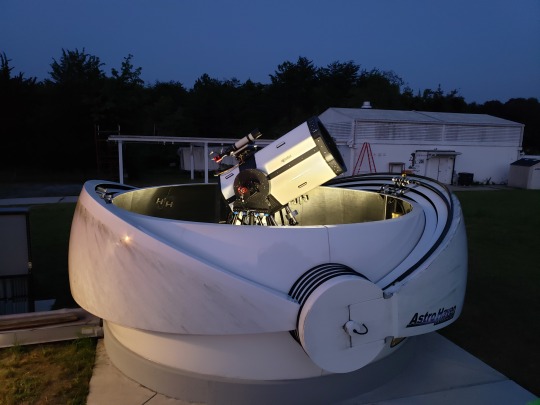
NASA’s LCOT (Low-Cost Optical Terminal), a ground station made of modified commercial hardware, transmitted its first laser communications uplink to the TBIRD (TeraByte Infrared Delivery), a tissue box-sized payload formerly in low Earth orbit.
During the first live sky test, NASA’s LCOT produced enough uplink intensity for the TBIRD payload to identify the laser beacon, connect, and maintain a connection to the ground station for over three minutes. This successful test marks an important achievement for laser communications: connecting LCOT’s laser beacon from Earth to TBIRD required one milliradian of pointing accuracy, the equivalent of hitting a three-foot target from over eight American football fields away.
The test was one of many laser communications achievements TBIRD made possible during its successful, two-year mission. Prior to its mission completion on Sept. 15, 2024, the payload transmitted at a record-breaking 200 gigabits per second. In an actual use case, TBIRD’s three-minute connection time with LCOT would be sufficient to return over five terabytes of critical science data, the equivalent of over 2,500 hours of high-definition video in a single pass. As the LCOT sky test demonstrates, the ultra-high-speed capabilities of laser communications will allow science missions to maintain their connection to Earth as they travel farther than ever before.
NASA’s SCaN (Space Communications and Navigation) program office is implementing laser communications technology in various orbits, including the upcoming Artemis II mission, to demonstrate its potential impact in the agency’s mission to explore, innovate, and inspire discovery.
“Optical, or laser, communications can transfer 10 to 100 times more data than radio frequency waves,” said Kevin Coggins, deputy associate administrator and SCaN program manager. “Literally, it’s the wave of the future, as it’ll enable scientists to realize an ever-increasing amount of data from their missions and will serve as our critical lifeline for astronauts traveling to and from Mars.”
Historically, space missions have used radio frequencies to send data to and from space, but with science instruments capturing more data, communications assets must meet increasing demand. The infrared light used for laser communications transmits the data at a shorter wavelength than radio, meaning ground stations on Earth can send and receive more data per second.
The LCOT team continues to refine pointing capabilities through additional tests with NASA’s LCRD (Laser Communications Relay Demonstration). As LCOT and the agency’s other laser communications missions continue to reach new milestones in connectivity and accessibility, they demonstrate laser communications’ potential to revolutionize scientists’ access to new data about Earth, our solar system, and beyond.
“It’s a testament to the hard work and skill of the entire team,” said Dr. Haleh Safavi, project lead for LCOT. “We work with very complicated and sensitive transmission equipment that must be installed with incredible precision. These results required expeditious planning and execution at every level.”
Experiments like TBIRD and LCRD are only two of SCaN’s multiple in-space demonstrations of laser communications, but a robust laser communications network relies on easily reconfigurable ground stations on Earth. The LCOT ground station showcases how the government and aerospace industry can build and deploy flexible laser communications ground stations to meet the needs of a wide variety of NASA and commercial missions, and how these ground stations open new doors for communications technology and extremely high data volume transmission.
NASA’s LCOT is developed by the agency’s Goddard Space Flight Center in Greenbelt, Maryland. TBIRD was developed in partnership with the Massachusetts Institute of Technology Lincoln Laboratory (MIT-LL) in Lexington. TBIRD was flown and operated as a collaborative effort among NASA Goddard; NASA’s Ames Research Center in California’s Silicon Valley; NASA’s Jet Propulsion Laboratory in Southern California; MIT-LL; and Terran Orbital Corporation in Irvine, California. Funding and oversight for LCOT and other laser communications demonstrations comes from the (SCaN) Space Communications and Navigation program office within the Space Operations Mission Directorate at NASA Headquarters in Washington.
0 notes
Text
NASA Achieves Milestone in Laser Communication

NASA’s Glenn Research Center in Cleveland has achieved a groundbreaking feat by successfully streaming 4K video footage from an aircraft to the International Space Station (ISS) and back using optical (laser) communications. This landmark event marks a significant shift from traditional radio wave communication, leveraging the power of infrared light to transmit data up to 100 times faster. The successful demonstration is part of a series of tests aimed at enhancing real-time video coverage for astronauts on the moon during the upcoming Artemis missions.
Historically, NASA has relied on radio waves to transmit information to and from space. However, laser communications offer a substantial upgrade, providing faster and higher data capacity. Working with the Air Force Research Laboratory and NASA’s Small Business Innovation Research program, Glenn engineers temporarily installed a portable laser terminal on a Pilatus PC-12 aircraft. The aircraft flew over Lake Erie, transmitting data to an optical ground station in Cleveland. The data was then sent through an Earth-based network to NASA’s White Sands Test Facility in New Mexico. From there, the infrared light signals travelled 22,000 miles to NASA’s Laser Communications Relay Demonstration (LCRD), which relayed them to the ILLUMA-T payload on the ISS, completing the round trip back to Earth.
Read More: (https://theleadersglobe.com/science-technology/nasa-achieves-milestone-in-laser-communication/)
#NASA#Laser Communication#traditional radio wave communication#global leader magazine#the leaders globe magazine#leadership magazine#world's leader magazine#article#best publication in the world#news#magazine#business
1 note
·
View note
Text
NASA’s Space Station Laser Comm Terminal Achieves First Link - Technology Org
New Post has been published on https://thedigitalinsider.com/nasas-space-station-laser-comm-terminal-achieves-first-link-technology-org/
NASA’s Space Station Laser Comm Terminal Achieves First Link - Technology Org
A NASA technology experiment on the International Space Station completed its first laser link with an in-orbit laser relay system on Dec. 5, 2023. Together, they complete NASA’s first two-way, end-to-end laser relay system.
NASA’s ILLUMA-T payload communicating with LCRD over laser signals. Image credit: NASA / Dave Ryan
NASA’s LCRD (Laser Communications Relay Demonstration) and the new space station demonstration, ILLUMA-T (Integrated LCRD Low Earth Orbit User Modem and Amplifier Terminal), successfully exchanged data for the first time.
LCRD and ILLUMA-T are demonstrating how a user mission, in this case the space station, can benefit from a laser communications relay located in geosynchronous orbit.
The benefits of laser communications: more efficient, lighter systems, increased security, and more flexible ground systems. Image credit: NASA / Dave Ryan
Laser communications, also known known as optical communications, uses infrared light rather than traditional radio waves to send and receive signals. The tighter wavelength of infrared light allows spacecraft to pack more data into each transmission. Using laser communications greatly increases the efficiency of data transfer and can lead to a faster pace of scientific discoveries.
NASA’s SpaceX 29th commercial resupply services mission launched cargo and new science experiments, including ILLUMA-T, to the space station. Following its arrival, the payload was installed onto the station’s Japanese Experiment Module-Exposed Facility.
ILLUMA-T and LCRD are a part of the NASA Space Communications and Navigation (SCaN) program’s effort to demonstrate how laser communications technologies can significantly benefit science and exploration missions.
“ILLUMA-T’s first link with LCRD – known as first light – is the latest demonstration proving that laser communications is the future.” said Dr. Jason Mitchell, director of SCaN’s Advanced Communications and Navigation Technology division.
“Laser communications will not only return more data from science missions, but could serve as NASA’s critical, two-way link to keep astronauts connected to Earth as they explore the Moon, Mars, and beyond.”
Shortly after space station installation, operation engineers began conducting on-orbit testing to ensure the ILLUMA-T payload operated nominally. Now, it is communicating with LCRD, a relay launched in 2021 that has conducted over 300 experiment configurations to help NASA refine laser communications technologies. LCRD and ILLUMA-T are exchanging data at 1.2 gigabits-per-second.
“We have demonstrated that we can overcome the technical challenges for successful space communications using laser communications. We are now performing operational demonstrations and experiments that will allow us to optimize our infusion of proven technology into our missions to maximize our exploration and science,” said David Israel, a NASA space communications and navigation architect.
NASA’s Laser Communications Roadmap: Demonstrating laser communications capabilities on multiple missions in a variety of space regimes. Image credit: NASA/Dave Ryan
The LCRD experiments are conducted with industry, academia, and other government agencies. ILLUMA-T is now LCRD’s first in-space user experiment. NASA is still accepting experiments to work with LCRD. Interested parties should contact [email protected] for more information.
Source: National Aeronautics and Space Administration
You can offer your link to a page which is relevant to the topic of this post.
#2023#Administration#aeronautics#astronauts#communications#data#data transfer#Discoveries#earth#efficiency#email#engineers#Featured Space news#Fundamental physics news#Future#Government#how#Industry#International Space Station#Israel#it#laser#lasers#Light#Link#mars#module#Moon#NASA#National Aeronautics and Space Administration
0 notes
Text
NASAs Space Station Laser Comm Terminal Achieves First Link
A NASA technology experiment on the International Space Station completed its first laser link with an in-orbit laser relay system on Dec. 5, 2023. Together, they complete NASA’s first two-way, end-to-end laser relay system. NASA’s LCRD (Laser Communications Relay Demonstration) and the new space station demonstration, ILLUMA-T (Integrated LCRD Low Earth Orbit User Modem and […] from NASA https://ift.tt/vsxVcMN
0 notes
Text
Laser Communications Revolution: NASA Space Breakthrough
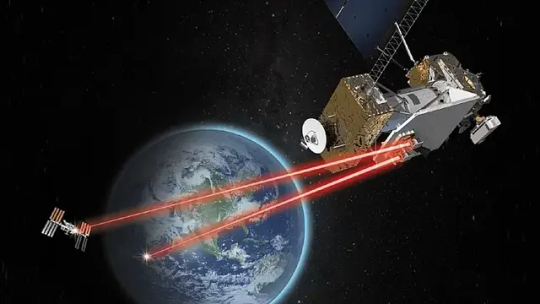
Advancing Laser Communications
In a remarkable display of cutting-edge technology, NASA is embarking on a mission to revolutionize data transmission from the International Space Station (ISS). The ILLUMA-T (Integrated Laser Communications Relay Demonstration Low Earth Orbit User Modem and Amplifier Terminal) payload will launch this November. It will showcase how laser communications enhance missions in low Earth orbit, clearing the path for scientific breakthroughs and exploration expeditions. Harnessing the Power of Infrared Light Laser communications, employing invisible infrared light, is poised to make a significant impact on the transmission of data. This breakthrough technology allows spacecraft to transmit and receive information at much higher data rates, granting them the ability to send copious amounts of data back to Earth in a single transmission, ultimately expediting discoveries for researchers.

NASA’s ILLUMA-T payload was delivered to SpaceX Dragonland. Photo by SpaceX. NASA.
ILLUMA-T: A Space Communications Game-Changer
Operated within NASA's Space Communications and Navigation (SCaN) program, ILLUMA-T pioneers a groundbreaking bi-directional, end-to-end laser communications relay. It collaborates with NASA's Laser Communications Relay Demonstration (LCRD), which embarked on its mission in December 2021. Together, ILLUMA-T and LCRD are laying the foundation for a new era in communication innovation. Currently, LCRD demonstrates the remarkable advantages of laser communications from geosynchronous orbit by transmitting data between two ground stations on Earth and conducting a series of groundbreaking experiments. Unveiling LCRD's Potential The LCRD experiments encompass a range of initiatives, including the examination of atmospheric effects on laser signals, verification of LCRD's ability to collaborate with multiple users, testing network capabilities like delay/disruption tolerant networking (DTN) over laser links, and the enhancement of navigation capabilities.
ILLUMA-T's Optical Module
ILLUMA-T's optical module comprises a telescope and a two-axis gimbal, enabling precise pointing and tracking of LCRD in geosynchronous orbit. Moreover, the compact optical module, compact, roughly the size of a microwave, and the payload itself, equivalent in size to a standard refrigerator, facilitate advanced space communication. The Data Relay Process Once installed on the exterior of the ISS, ILLUMA-T will facilitate the relay of data from the space station to LCRD at an impressive speed of 1.2 gigabits per second. LCRD will then transmit the data to optical ground stations in California or Hawaii. Following this, the data will route to NASA's LCRD Mission Operations Center at the White Sands Complex in Las Cruces, New Mexico. Engineers at NASA's Goddard Space Flight Center in Greenbelt, Maryland, will then verify the accuracy and quality of the data sent through this end-to-end relay process.
Paving the Way for Enhanced Data Transmission
"Illuminating" the potential of laser communications, ILLUMA-T, and LCRD are poised to transform space communications capabilities. Following the experimental phase with LCRD, ILLUMA-T could become an integral part of the space station, significantly increasing the volume of data NASA can send to and from the orbiting laboratory. Revolutionizing Space Communications While the space station has historically relied on radio frequency relay satellites for data transmission, laser communications have the potential to be a game-changer for researchers on Earth conducting experiments aboard the ISS. In fields ranging from biological and physical sciences to technology and Earth observations, astronauts conduct research for the benefit of humanity. ILLUMA-T offers the capacity to significantly enhance data rates for these experiments, capable of sending the equivalent of an average movie's worth of data in under a minute, at an astounding speed of 1.2 Gbps.
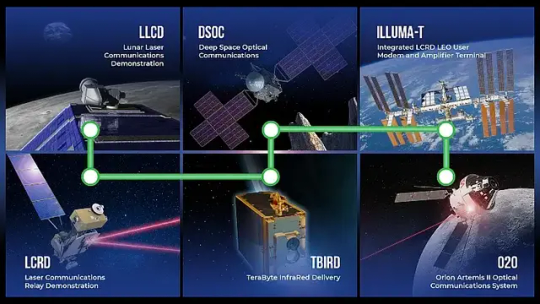
NASA’s Laser Communications Roadmap – proving the technology’s validity in a variety of regimes. Photo by Dave Ryan. NASA.
A Leap Forward in Space Communications
This monumental ILLUMA-T / LCRD end-to-end laser communications relay system represents a crucial step forward in space communications capabilities. In conjunction with past and upcoming demonstrations, NASA is highlighting the transformative potential of laser communications systems for both near-Earth and deep space exploration. A Future of Laser Communications The goal of these demonstrations is to seamlessly integrate laser communications as a capability within NASA's space communications networks—the Near Space Network and Deep Space Network. Mission planners interested in leveraging laser communications are encouraged to reach out to [email protected].
Advancing Space Communications Through Innovation
NASA's Laser Communication Initiatives The ILLUMA-T payload, funded by the Space Communications and Navigation (SCaN) program at NASA Headquarters in Washington, is under the management of NASA's Goddard Space Flight Center in Greenbelt, Maryland. The project enjoys collaborative support from the International Space Station program office at NASA's Johnson Space Center in Houston and the Massachusetts Institute of Technology (MIT) Lincoln Laboratory in Lexington, Massachusetts. LCRD, spearheaded by Goddard in collaboration with NASA's Jet Propulsion Laboratory in Southern California and the MIT Lincoln Laboratory, receives funding through NASA's Technology Demonstration Missions program, which falls under the Space Technology Mission Directorate, and the Space Communications and Navigation (SCaN) program at NASA Headquarters in Washington. Sources: THX News & NASA. Read the full article
#CommunicationBreakthroughs#ILLUMA-TandLCRD#ILLUMA-TMission#InfraredLightBenefits#LaserCommunicationRevolution#LaserCommunications#LaserTechnologyAdvancements#NASALaserRelay#SpaceDataTransmission#SpaceStationDataTransfer
0 notes
Link
3 Min Read NASA’s Space Station Laser Comm Terminal Achieves First Link NASA’s ILLUMA-T payload at Goddard Space Flight Center fully tested and integrated prior to its delivery to Kennedy Space Center. Credits: NASA's Goddard Space Flight Center A NASA technology experiment on the International Space Station completed its first laser link with an in-orbit laser relay system on Dec. 5, 2023. Together, they complete NASA’s first two-way, end-to-end laser relay system. NASA’s LCRD (Laser Communications Relay Demonstration) and the new space station demonstration, ILLUMA-T (Integrated LCRD Low Earth Orbit User Modem and Amplifier Terminal), successfully exchanged data for the first time. LCRD and ILLUMA-T are demonstrating how a user mission, in this case the space station, can benefit from a laser communications relay located in geosynchronous orbit. NASA’s ILLUMA-T payload communicating with LCRD over laser signals.NASA / Dave Ryan Laser communications, also known known as optical communications, uses infrared light rather than traditional radio waves to send and receive signals. The tighter wavelength of infrared light allows spacecraft to pack more data into each transmission. Using laser communications greatly increases the efficiency of data transfer and can lead to a faster pace of scientific discoveries. The benefits of laser communications: more efficient, lighter systems, increased security, and more flexible ground systems.NASA / Dave Ryan On Nov. 9, NASA’s SpaceX 29th commercial resupply services mission launched cargo and new science experiments, including ILLUMA-T, to the space station. Following its arrival, the payload was installed onto the station’s Japanese Experiment Module-Exposed Facility. The SpaceX Falcon 9 rocket carrying the Dragon spacecraft lifts off from Launch Complex 39A at NASA’s Kennedy Space Center in Florida on Thursday, Nov. 9, 2023, on the company’s 29th commercial resupply services mission for the agency to the International Space Station. Liftoff was at 8:28 p.m. EST. SpaceX ILLUMA-T and LCRD are a part of the NASA Space Communications and Navigation (SCaN) program’s effort to demonstrate how laser communications technologies can significantly benefit science and exploration missions. “ILLUMA-T’s first link with LCRD – known as first light – is the latest demonstration proving that laser communications is the future.” said Dr. Jason Mitchell, director of SCaN’s Advanced Communications and Navigation Technology division. “Laser communications will not only return more data from science missions, but could serve as NASA’s critical, two-way link to keep astronauts connected to Earth as they explore the Moon, Mars, and beyond.” To view this video please enable JavaScript, and consider upgrading to a web browser that supports HTML5 video NASA's ILLUMA-T payload achieved First Light with LCRD. In this video, Matt Magsamen explains the First Light milestone. Shortly after space station installation, operation engineers began conducting on-orbit testing to ensure the ILLUMA-T payload operated nominally. Now, it is communicating with LCRD, a relay launched in 2021 that has conducted over 300 experiment configurations to help NASA refine laser communications technologies. LCRD and ILLUMA-T are exchanging data at 1.2 gigabits-per-second. “We have demonstrated that we can overcome the technical challenges for successful space communications using laser communications. We are now performing operational demonstrations and experiments that will allow us to optimize our infusion of proven technology into our missions to maximize our exploration and science,” said David Israel, a NASA space communications and navigation architect. NASA’s Laser Communications Roadmap: Demonstrating laser communications capabilities on multiple missions in a variety of space regimes.NASA/Dave Ryan The LCRD experiments are conducted with industry, academia, and other government agencies. ILLUMA-T is now LCRD’s first in-space user experiment. NASA is still accepting experiments to work with LCRD. Interested parties should contact [email protected] for more information. ILLUMA-T is funded by NASA’s Space Communications and Navigation (SCaN) program at NASA Headquarters in Washington. The payload is managed by NASA’s Goddard Space Flight Center in Greenbelt, Maryland. Partners include the International Space Station program office at NASA’s Johnson Space Center in Houston and the Massachusetts Institute of Technology Lincoln Laboratory in Lexington, Massachusetts. For more information: https://nasa.gov/scan About the AuthorKatherine SchauerKatherine Schauer is a writer for the Space Communications and Navigation (SCaN) program office and covers emerging technologies, commercialization efforts, exploration activities, and more. Share Details Last Updated Dec 18, 2023 ContactKatherine [email protected] Space Flight Center Related TermsCommunicating and Navigating with MissionsGeneralGoddard Space Flight CenterInternational Space Station (ISS)ISS ResearchLaser Communications RelaySpace Communications & Navigation ProgramTechnology Demonstration Explore More 5 min read NASA’s First Two-way End-to-End Laser Communications Relay System Article 2 months ago 6 min read NASA’s Laser Communications Relay: A Year of Experimentation NASA’s first two-way laser relay system completed its first year of experiments on June 28… Article 6 months ago 4 min read NASA to Demonstrate Laser Communications from Space Station In 2023, NASA is sending a technology demonstration known as the Integrated LCRD Low Earth… Article 4 months ago
0 notes
Text
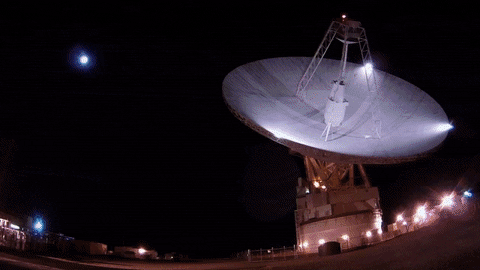
9 Out-of-This-World Moments for Space Communications & Navigation in 2023
How do astronauts and spacecraft communicate with Earth?
By using relay satellites and giant antennas around the globe! These tools are crucial to NASA’s space communications networks: the Near Space Network and the Deep Space Network, which bring back science and exploration data every day.
It’s been a great year for our space communications and navigation community, who work to maintain the networks and enhance NASA’s capabilities. Keep scrolling to learn more about our top nine moments.

The SpaceX Falcon 9 rocket carrying the Dragon spacecraft lifts off from Launch Complex 39A at NASA's Kennedy Space Center in Florida on Thursday, Nov. 9, 2023, on the company's 29th commercial resupply services mission for the agency to the International Space Station. Liftoff was at 8:28 p.m. EST.
1. In November, we launched a laser communications payload, known as ILLUMA-T, to the International Space Station. Now, ILLUMA-T and the Laser Communications Relay Demonstration (LCRD) are exchanging data and officially complete NASA’s first two-way, end-to-end laser relay system. Laser communications can send more data at once than traditional radio wave systems – think upgrading from dial-up to fiber optic internet. ILLUMA-T and LCRD are chatting at 1.2 gigabits per second (Gbps). At that rate, you could download an average movie in under a minute.
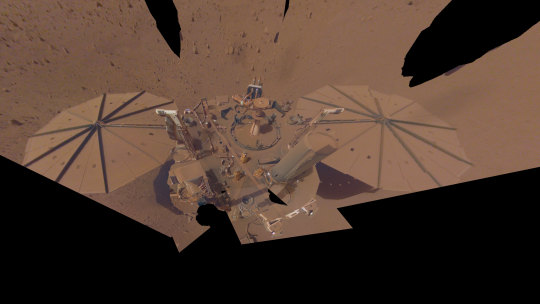
NASA’s InSight lander captured this selfie on Mars on April 24, 2022, the 1,211th Martian day, or sol, of the mission.
2. Data analyzed in 2023 from NASA’s retired InSight Mars lander provided new details about how fast the Red Planet rotates and how much it wobbles. Scientists leveraged InSight’s advanced radio technology, upgrades to the Deep Space Network, and radio signals to determine that Mars’ spin rate is increasing, while making the most precise measurements ever of Mars’ rotation.
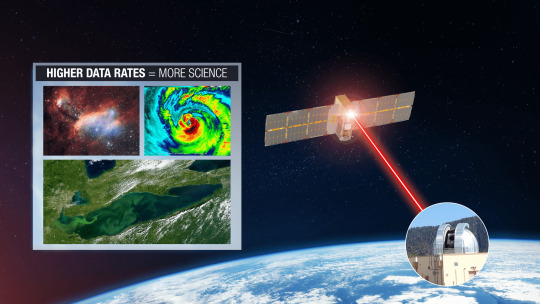
TBIRD is demonstrating a direct-to-Earth laser communications link from low Earth orbit to a ground station on Earth.
3. We set a new high record! The TeraByte InfraRed Delivery (TBIRD) payload – also demonstrating laser communications like ILLUMA-T and LCRD – downlinked 4.8 terabytes of data at 200 Gbps in a single 5-minute pass. This is the highest data rate ever achieved by laser communications technology. To put it in perspective a single terabyte is the equivalent of about 500 hours of high-definition video.
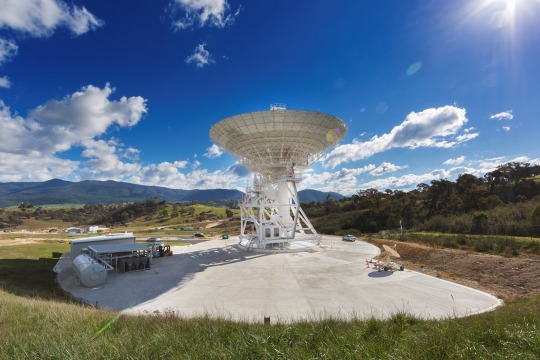
A 34-meter (112-foot) wide antenna at Canberra Deep Space Communications Complex near Canberra, Australia.
4. This year we celebrated the Deep Space Network’s 60th anniversary. This international array of antennas located at three complexes in California, Spain, and Australia allow us to communicate with spacecraft at the Moon and beyond. Learn more about the Deep Space Network’s legacy and future advancements.
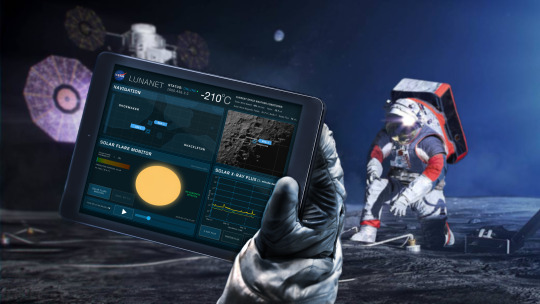
An illustration of the LunaNet architecture. LunaNet will bring internet-like services to the Moon.
5. We are bringing humans to the Moon with Artemis missions. During expeditions, astronauts exploring the surface are going to need internet-like capabilities to talk to mission control, understand their routes, and ensure overall safety. The space comm and nav group is working with international partners and commercial companies to develop LunaNet, and in 2023, the team released Draft LunaNet Specification Version 5, furthering development.
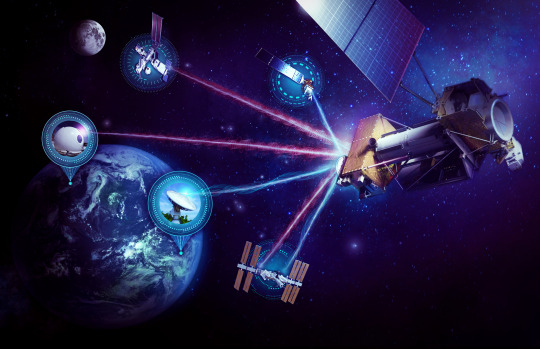
The High-Rate Delay Tolerant Networking node launched to the International Space Station in November and will act as a high-speed path for data.
6. In addition to laser communications, ILLUMA-T on the International Space Station is also demonstrating high-rate delay/disruption tolerant networking (HDTN). The networking node is showcasing a high-speed data path and a store-and-forward technique. HDTN ensures data reaches its final destination and isn’t lost on its path due to a disruption or delay, which are frequent in the space environment.

The Communications Services Project (CSP) partners with commercial industry to provide networking options for future spaceflight missions.
7. The space comm and nav team is embracing the growing aerospace industry by partnering with commercial companies to provide multiple networking options for science and exploration missions. Throughout 2023, our commercialization groups engaged with over 110 companies through events, one-on-one meetings, forums, conferences, and more. Over the next decade, NASA plans to transition near-Earth services from government assets to commercial infrastructure.
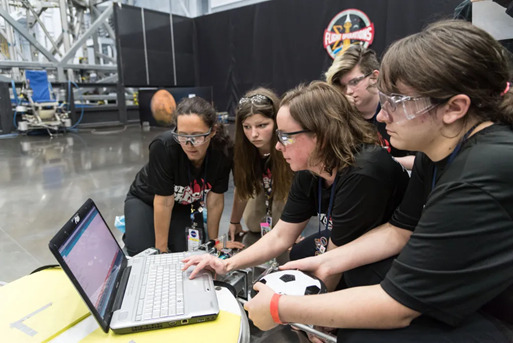
Middle and high school students solve a coding experiment during NASA's Office of STEM Engagement App Development Challenge.
8. Every year, NASA’s Office of STEM Engagement sponsors the App Development Challenge, wherein middle and high school students must solve a coding challenge. This year, student groups coded an application to visualize the Moon’s South Pole region and display information for navigating the Moon’s surface. Our space communications and navigation experts judged and interviewed students about their projects and the top teams visited NASA’s Johnson Space Center in Houston!
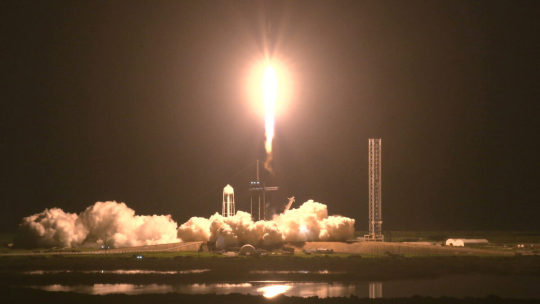
A SpaceX Falcon 9 rocket soars upward after liftoff at the pad at 3:27 a.m. EDT on Saturday, Aug. 26, from Kennedy Space Center’s Launch Complex 39A in Florida carrying NASA’s SpaceX Crew-7 crew members to the International Space Station. Aboard SpaceX’s Dragon spacecraft are NASA astronaut Jasmin Moghbeli, ESA (European Space Agency) astronaut Andreas Mogensen, JAXA (Japan Aerospace Exploration Agency) astronaut Satoshi Furukawa, and Roscosmos cosmonaut Konstantin Borisov.
9. The Near Space Network supported 19 launches in 2023! Launches included Commercial Crew flights to the International Space Station, science mission launches like XRISM and the SuperBIT balloon, and many more. Once in orbit, these satellites use Near Space Network antennas and relays to send their critical data to Earth. In 2023, the Near Space Network provided over 10 million minutes of communications support to missions in space.
Here’s to another year connecting Earth and space.
Make sure to follow us on Tumblr for your regular dose of space!
1K notes
·
View notes
Text
SpaceX resupply mission will bring NASA laser communication system to ISS this year
Space.com By Rahul Rao August 30, 2023 Later this year, SpaceX’s 29th Commercial Resupply Services mission will lift a refrigerator-sized device to the International Space Station. This device — given the catchy name of Integrated LCRD Low Earth Orbit User Modem and Amplifier Terminal (ILLUMA-T) — will complete NASA’s first two-way, end-to-end laser communications system. Harnessing laser beams,…
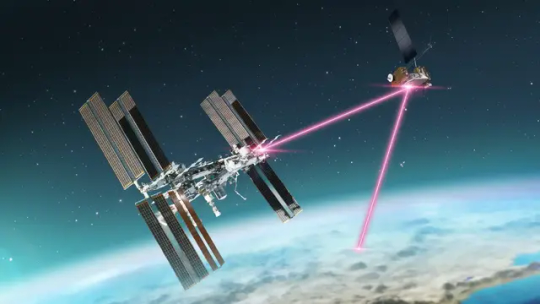
View On WordPress
0 notes
Text
NASA s demostrara comunicación laser desde la estación espacial internacional
NASA s demostrara comunicación laser desde la estación espacial internacional Durante más de 20 años, la estación espacial ha proporcionado una plataforma única para la investigación en áreas como biología, tecnología, agricultura y más.
La NASA utiliza la Estación Espacial Internacional (una nave espacial del tamaño de un campo de fútbol que orbita la Tierra) para aprender más sobre cómo vivir y trabajar en el espacio La carga útil ILLUMA-T de la NASA se comunica con LCRD a través de señales láser. Créditos: NASA/Dave Ryan Durante más de 20 años, la estación espacial ha proporcionado una plataforma única para la investigación…
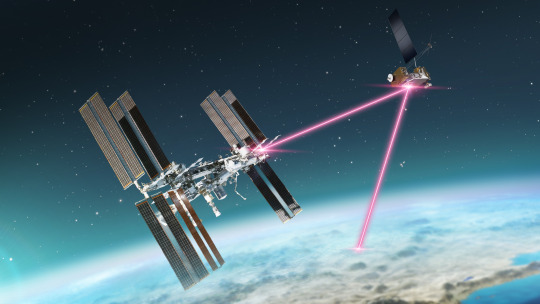
View On WordPress
#Centro de Vuelo Espacial Goddard#Comunicación#demostración de tecnología#Estación Espacial#NASA#tecnología espacial
0 notes
Photo
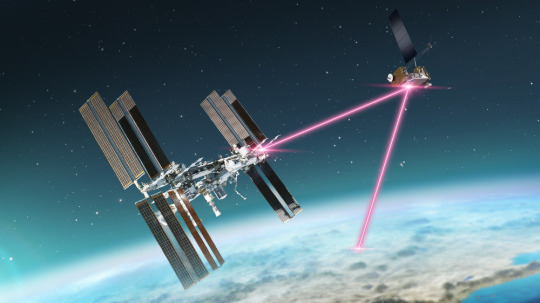
SpaceX resupply mission will bring NASA laser communication system to ISS this year
---
1 note
·
View note